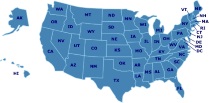State History
Learn about the history of Oklahoma and find fun and interesting things to do and see all across Oklahoma. We've also found the best books, guides, websites, and other resources to make your study of Oklahoma fun and educational.
Things to See & Do in Oklahoma
Oklahoma City National Memorial
Oklahoma City National Memorial honors the victims, survivors, rescuers, and all who were changed forever on April 19, 1995. Located on 3.3 acres, the outdoor Symbolic Memorial consists of the Gates of Time entrance gates, Reflecting Pool, Children's Area, Rescuers' Orchard, the "Survivor Tree," and the Memorial Fence.
Washita Battlefield National Historic Site
Washita Battlefield National Historic Site protects and interprets the site of the Southern Cheyenne village of Peace Chief Black Kettle that was attacked by the 7th U.S. Cavalry under Lt. Col. George A. Custer just before dawn on November 27, 1868. The controversial strike was hailed at the time by the military and many civilians as a significant victory aimed at reducing Indian raids on frontier settlements. Washita remains controversial because many Indians and whites labeled Custer's attack a massacre. Black Kettle is still honored as a prominent leader who never ceased striving for peace even though it cost him his life.
Fort Smith National Historic Site
At Fort Smith National Historic Site you can walk where soldiers drilled, pause along the Trail of Tears, and stand where justice was served. The park includes the remains of two frontier forts and the Federal Court for the Western District of Arkansas. Exhibits in the visitor center focus on Fort Smith’s military history from 1817 – 1871, western expansion, Judge Isaac C. Parker and the federal court’s impact on Indian Territory, U.S. Deputy Marshals and outlaws, Federal Indian policy, and Indian Removal including the Trail of Tears. Located on the grounds are the foundation remains of the first Fort Smith (1817-1824), the Commissary building (c. 1838) and a reconstruction of the gallows used by the federal court. A walking trail along the Arkansas River includes wayside exhibits on the Trail of Tears.
Santa Fe National Historic Trail
Between 1821 and 1880, the Santa Fe Trail was primarily a commercial highway connecting Missouri and Santa Fe, New Mexico. From 1821 until 1846, it was an international commercial highway used by Mexican and American traders. In 1846, the Mexican-American War began. The Army of the West followed the Santa Fe Trail to invade New Mexico. When the Treaty of Guadalupe ended the war in 1848, the Santa Fe Trail became a national road connecting the United States to the new southwest territories. Commercial freighting along the trail continued, including considerable military freight hauling to supply the southwestern forts. The trail was also used by stagecoach lines, thousands of gold seekers heading to the California and Colorado gold fields, adventurers, fur trappers, and emigrants. In 1880 the railroad reached Santa Fe and the trail faded into history.
Teaching Tips & Ideas
Knowledge Quest
Knowledge Quest offers historical outline maps and timelines designed for the interactive study of world history and geography.
How I Teach a Large Family in a Relaxed, Classical Way: History
A look at teaching history across several grades using the classical method of education and a rotation of history every four years.
Featured Resources
As an Amazon Associate, we earn from qualifying purchases. We get commissions for purchases made through links on this site.
Five in a Row
Five in a Row provides a step-by-step, instructional guide using outstanding children's literature for children ages 4-8. Unit studies are built around each chosen book. There is a series for preschoolers called "Before Five in a Row," along with other volumes for older children.
Reading Made Easy
Reading Made Easy is a phonics-based program, featuring 108 easy lessons, designed to be taught in less than 30 minutes per day. It is fully scripted and has original Christian content and stories. Includes hands-on writing and drawing activities. Reading Made Easy can be purchased here.
Homeschooling: The Early Years: Your Complete Guide to Successfully Homeschooling the 3- to 8- Year-Old Child
Nothing beats seeking the voice of experience if you want to join the estimated 1 to 3 million parents who teach their children at home. Here's a guide that comes direct from the experts: a mother of two homeschooled, now-grown children and 83 homeschooling families she surveyed. Their stories make reading this starter kit on teaching ages 3 to 7 worthwhile. For those ready to take on what author Linda Dobson calls "a natural extension of being a good parent," the manual provides at-a-glance box...
Pecci Reading Method: At Last! A Reading Method for Every Child
At Last! A Reading Method for Every Child offers a balanced approach with intensive phonics and literature-based reading instruction. This is a simple method of teaching reading, with lots of supplemental materials. Get product information here.
Real Lives: Eleven Teenagers Who Don't Go to School
Grace Llewellyn, author of the The Teenage Liberation Handbook, offers the stories of 11 teens who made the decision to reject traditional schooling methodologies and take their education into their own hands. The essays highlight offer a day-in-the-life look at teen homeschooling and unschooling, as the teens embraced self-education and increased in their self-confidence and motivation.


